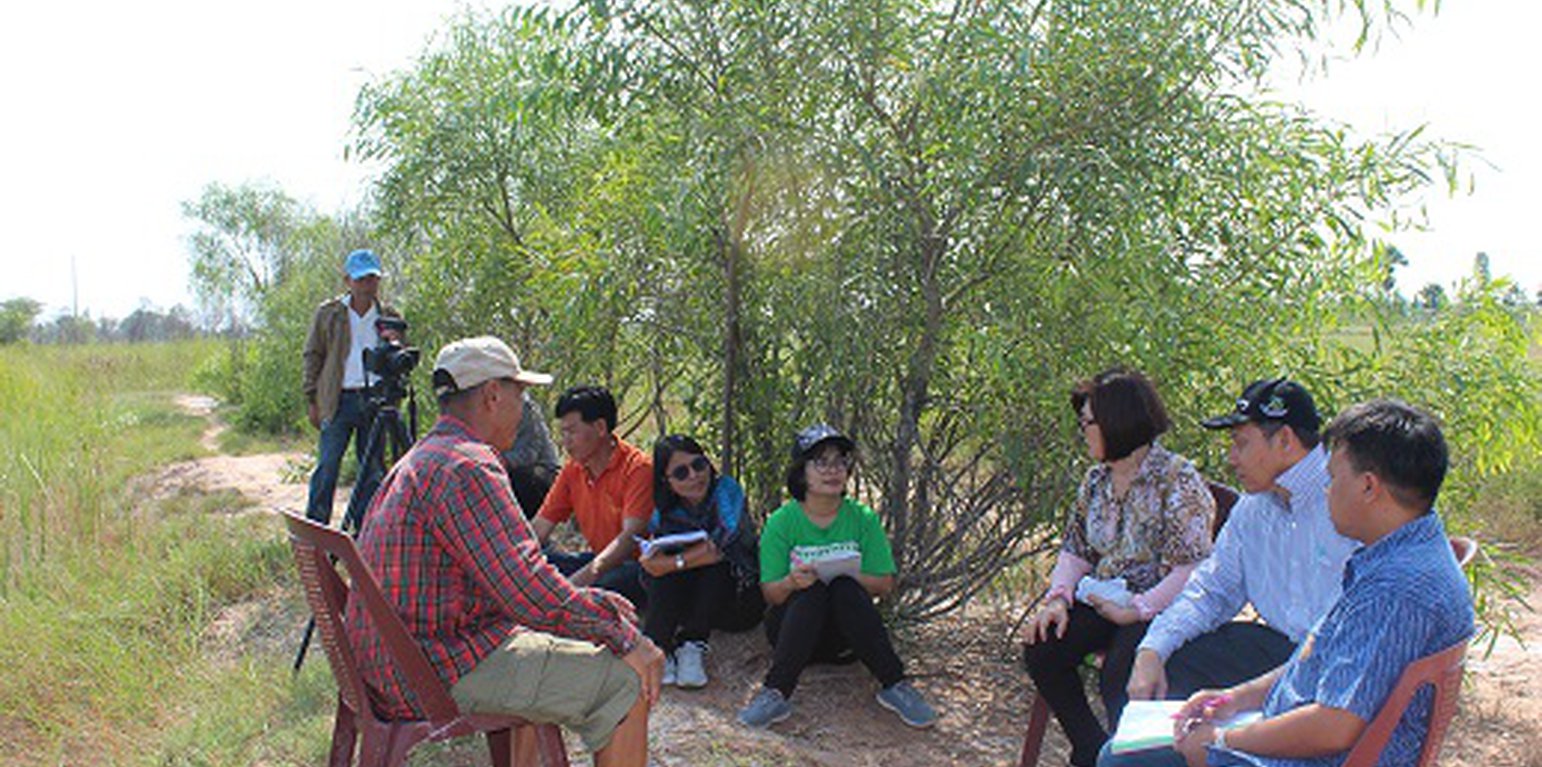Vegetative approach of using a halophyte ("Dixie grass", Sporobolus virginicus)) to rehabilitate severely salt-affected land.
(Tailândia)
Descrição
The government promotes a halophyte (Dixie grass) to control severely salt-affected land, rehabilitate the ecosystem and prevent the spread of salt in soil - with the cooperation of land owners, livestock farmers, the local administration, the local government agency, Land Development Department researchers and with specialists/ technical advisors in various fields.
The Ministry of Agriculture and Cooperatives through its Land Development Department (LDD) initiated a project on planting salt-tolerant trees and grasses on severely salt-affected land in the Northeast of Thailand in 1996. The project has facilitated the planting of a halophyte (a salt-loving plant), namely Sporobulus virginicus (Dixie grass) on salt-crusted and barren land. The main objectives of the approach has been to encourage land users to maximize their land area for farming, by preventing the formation of extensive severely saline soil. This is through planting Dixie grass as a cover crop to rehabilitate the land and ecosystem. The activities started with public meetings, then identifying severely salt-affected areas, and setting-up demonstration plots on farmers’ land to act as learning centers. There has also been communication with the local administration to call farmers’ meetings to develop detailed work plans and discuss strengths, weaknesses, opportunities, and threats of planting Dixie grass. The implementing activities consisted of 4 stages; PREPARATION was for seedling preparation, site selection of severely salt-affected soil and land preparation, public meetings and the establishment of the demonstration plot at Dan Chang Sub-district, Buayai District, Nakhon Ratchasima Province. COORDINATION included a joint meeting between farmers and researchers, joint monitoring & evaluation and follow-up and land users' decision-making. PLANTING started with selection of farmers joining the project, facilitating and training, a site visit to the model demonstration plot: this plot is the model for planting salt-tolerant trees and grasses on severely salt-affected land in the Northeast of Thailand. The final activity of SCALING-OUT occured when the land users/ farmers found that after 3 years of planting Dixie grass this barren land became covered by plants and much improved in biodiversity by the evidence of many varieties of wild grasses, flowers, dragonflies, small mammals and birds. Farmers could now grow rice and they used Dixie grass as feed for livestock. Moreover, and attractively, farmers were able to increase their incomes. Migration to big cities was reduced. The stakeholders were land owners, livestock farmers, the local administration, the local government agency, researchers and SLM specialists from LDD - and all worked together to mutual benefit. Nevertheless, although planting halophytes improves severely saline soil with low input costs, the recovery/accomplishment time (in saline soil improvement) cannot be as fast as that of engineering measures with much higher investment.
Localização
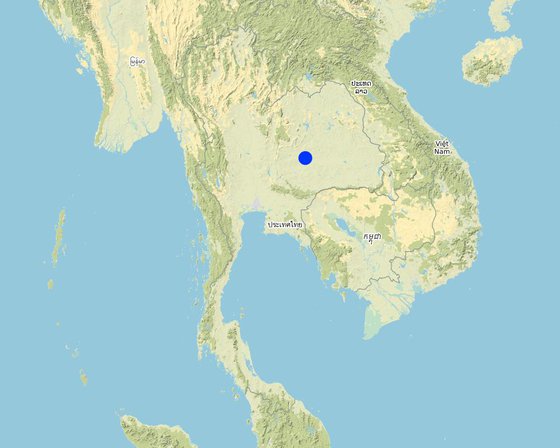
Localização: 6 Ban Donpae Moo 8, Kut Chok Sub-district, Buayai District, Nakhon Ratchasima Province, Tailândia
Geo-referência de locais selecionados
Data de início: 2015
Ano de término: 2016
Tipo de abordagem
-
Tradicional/Indígena
-
Iniciativa/inovação local recente
-
Baseado em projeto/programa
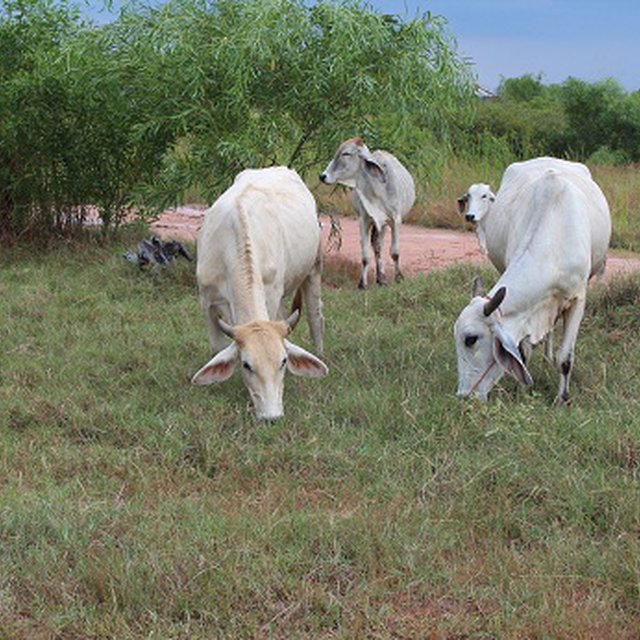
Dixie grass as pasture for cattle. (Kamontip Sasithorn)
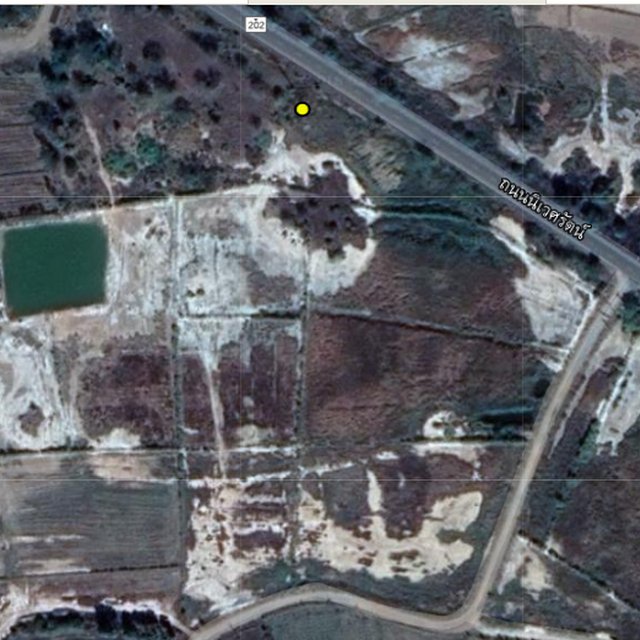
Selected sites for scaling-out planting Dixie grass on heavily salt-affected land. (Jutharat Rattanapunya)
Objetivos de aproximação e ambiente propício
Principais metas / objetivos da abordagem
The main objective of the approach was to enable and encourage land users to maximize land for farming, through preventing the formation of extensive severely saline soil, by the use of the halophyte, Dixie grass, as a cover crop.
Condições que permitem a implementação da Tecnologia(s) aplicada(s) sob a Abordagem
-
Normas e valores sociais/culturais/religiosos: The land users follow what their neighbours practice.
-
Disponibilidade/acesso a recursos e serviços financeiros: Through the Bank for Agriculture and Agricultural Cooperatives.
-
Quadro institucional: Local administration
-
Colaboração/coordenção de atores: Coordination of soil doctor volunteers and community leaders in the area.
-
Políticas: The government has a policy of preventing soil degradation.
-
Conhecimento sobre GST, acesso a suporte técnico: To provide knowledge to land users in the area.
-
Carga de trabalho, disponibilidade de força de trabalho: For land users under the project
Condições que dificultam a implementação da Tecnologia(s) aplicada(s) sob a Abordagem
-
Carga de trabalho, disponibilidade de força de trabalho: For land users outside the project
Participação e papel das partes interessadas envolvidas
Partes interessadas envolvidas na abordagem e seus papéis
| Que partes interessadas/órgãos de implementação estavam envolvidos na abordagem? |
Especifique as partes interessadas |
Descreva o papel das partes interessadas |
| Usuários de terra/comunidades locais |
Farmers under the project |
Planting halophytes (Sporobolus virginicus - Dixie grass) |
| Organizações comunitárias |
Local administration (Sub-district Administration Organization) |
Call for meeting |
| Especialistas em GST/ consultor agrícola |
Land Development Department |
Site selection |
| Pesquisadores |
Land Development Department |
Provide technical recommendations |
| Governo nacional (planejadores, responsáveis pelas decisões) |
Land Development Department |
Funding, planner, decision-makers |
Envolvimento do usuários de terra/comunidades locais nas diferentes fases da abordagem
Nenhum
Passivo
Apoio externo
Participativo
Automobilização
Iniciação/motivação
Land users in the project based
Planejamento
Discussion with land users on work plan before starting the
activity.
Implementação
Land users/farmers in the project
Monitoramento/avaliação
Land users in the project
Fluxograma
Four stages of participating process of technology development among organizations, community volunteers on soil improvement, farmers, SLM specialists and researchers.
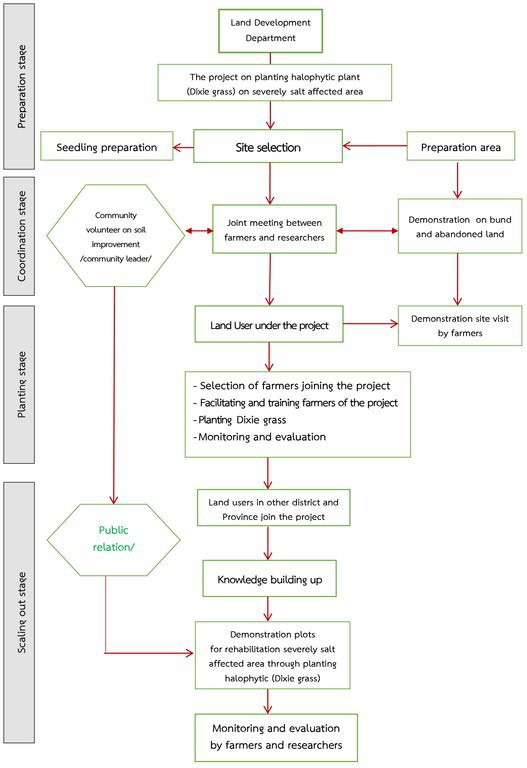
Autor: Kamontip Sasithorn
Tomada de decisão sobre a seleção da Tecnologia GST
As decisões foram tomadas por
-
Somente usuários da terra (iniciativa própria)
-
Principalmente usuários da terra, apoiados por especialistas em GST
-
todos os atores relevantes, como parte de uma abordagem participativa
-
Principalmente especialistas em GST, após consulta com usuários da terra
-
Somente especialistas em GST
-
Políticos/líderes
As decisões foram tomadas com base em
-
Avaliação de conhecimento bem documentado de GST (tomada de decisão baseada em evidências)
-
Resultados de pesquisa
-
Experiência pessoal e opiniões (não documentado)
Suporte técnico, reforço das capacidades e gestão do conhecimento
As seguintes atividades ou serviços têm sido parte da abordagem
-
Reforço das capacidades/ formação
-
Serviço de consultoria
-
Fortalecimento da instituição (desenvolvimento organizacional)
-
Monitoramento e avaliação
-
Pesquisa
Reforço das capacidades/formação
Foi fornecido treinamento às seguintes partes interessadas
-
Usuários de terra
-
Equipe de campo/consultores
Tipo de formação
-
Em exercício
-
Agricultor para agricultor
-
Áreas de demonstração
-
Reuniões públicas
-
Cursos
Assuntos abordados
Prevention and rehabilitation of salt-affected land with available technology and increased income for farmers.
Serviço de consultoria
Foi prestado um serviço de consultoria
-
nas áreas dos usuários da terra
-
Em centros permanentes
1. Soil doctor volunteers represent the Land Development Department with a duty to provide knowledge to farmers in the area.
2. SLM specialists from Land Development Department visited and advised farmers in the area.
Monitoramento e avaliação
SLM specialists from Land Development Department collaborated with LDD soil doctor volunteers in surveying the survival rate and following up the growth of plants in the area.
Pesquisa
As pesquisas trataram dos seguintes tópicos
-
Sociologia
-
Economia/Marketing
-
Ecologia
-
Tecnologia
The Soil Salinity Research Group, LDD, conducted research on "halophytes plantation and the flow path along the landscape in Northeast Thailand" with Dr. J.L. Gallagher from Delaware Biotechnology Institute, University of Delaware.
Financiamento e apoio material externo
Orçamento anual em USD para o componente GST
-
< 2.000
-
2.000-10.000
-
10.000-100.000
-
100.000-1.000.000
-
> 1.000.000
Precise annual budget: n.a.
Land Development Department
Os seguintes serviços ou incentivos foram fornecidos aos usuários de terras
-
Apoio financeiro/material concedido aos usuários da terra
-
Subsídios para insumos específicos
-
Crédito
-
Outros incentivos ou instrumentos
Apoio financeiro/material concedido aos usuários da terra
Dixie grass planting material and land preparation cost
Parcialmente financiado
Totalmente financiado
A mão-de-obra dos usuários da terra foi
-
Voluntário
-
Comida por trabalho
-
Pago em dinheiro
-
Recompensado com outras formas de apoio material
Análise de impactos e declarações finais
Impactos da abordagem
Não
Sim, pouco
Sim, moderadamente
Sim, significativamente
A abordagem concedeu autonomia aos usuários locais de terra, melhorou a participação das partes interessadas?
Generate food security and family income.
A abordagem propiciou a tomada de decisão baseada em evidências?
Establish learning center for farmers as an information for technology adoption.
A abordagem auxiliou os usuários da terra a implementar e manter as tecnologias de GST?
Farmers well adopted the technology, resulting in the expansion of such Approach to a wider area.
A abordagem aprimorou o conhecimento e as capacidades dos usuários da terra para implementar a GST?
Farmers have adapted and changed SLM model to suit their own preference.
A abordagem resultou em segurança alimentar aprimorada/nutrição melhorada?
Farmers can grow rice and they use Dixie grass as feed for livestock.
A abordagem resultou em emprego, oportunidades de renda?
The migration for job to big cities has reduced.
Principal motivação dos usuários da terra para implementar a GST
-
Produção aumentada
-
Lucro (lucrabilidade) aumentado, melhora da relação custo-benefício
-
Degradação do solo reduzida
-
Riscos de desastre reduzido
-
Carga de trabalho reduzida
-
Pagamentos/subsídios
-
normas e regulamentos (multas)/aplicação
-
Prestígio, pressão social/coesão social
-
Afiliação a movimento/projeto/grupo/rede
-
Consciência ambiental
-
Costumes e crenças, moral
-
melhoria dos conhecimentos e aptidões de GST
-
Melhoria estética
-
Atenuação de conflitos
Atividades de sustentabilidade de abordagem
Os usuários da terra podem sustentar o que foi implementado através da Abordagem (sem apoio externo)?
Farmers have better understanding and positive attitude of planting halophytes (e.g. Dixie grass). Moreover, they have more income generated from rice yield and livestock, as farmers can now grow rice and used Dixie grass to raise livestock.
Conclusões e experiências adquiridas
Pontos fortes: visão do usuário de terra
-
Soil doctor volunteer, local government agency and community leader were the coordinators in the area.
-
Farmers had easy access to markets and sources of Dixie grass cuttings.
-
Distribution of Dixie grass cuttings was done at no cost.
Pontos fortes: a visão do/a compilador/a ou de outra pessoa capacitada
-
A supported technique created to make better environment on severely saline soil in the Northeast of Thailand.
-
Technique in planting Dixie grass was provided continually by Land Development Department and community volunteers on soil improvement.
-
A demonstrated plot was established in the area.
Pontos fracos/desvantagens/riscos: visão do usuário de terracomo superar
-
Advertising of project was not extensive enough, particularly to the area of severely saline soil.
It is necessary for the Land Development Department to cooperate more closely with local administration to promote the project.
Pontos fracos/desvantagens/riscos: a visão do/a compilador/a ou de outra pessoa capacitadacomo superar
-
Some farmers did not believe that Dixie grass was very salt tolerant and will make the salinity of the soil decrease after planting it.
The officers should build up knowledge from successful farmers by frequently visiting farmers in the area under the project "rehabilitation of severely salt-affected soil by planting Dixie grass".
Referências
Revisor
-
Rima Mekdaschi Studer
-
Samran Sombatpanit
-
William Critchley
Data da documentação: 19 de Novembro de 2018
Última atualização: 29 de Dezembro de 2020
Pessoas capacitadas
-
Somsak Yooburi - usuário de terra
-
Rungariam Sriwootpong - usuário de terra
-
Chiwat Auonpokang - Department of Agricultural Extension officer
-
Noorian Kumtisong - usuário de terra
-
Pirach Pongwichian (pirach.ldd@gmail.com) - Especialista em GST
-
Kamontip Sasithorn (misskamonthip@gmail.com) - Especialista em GST
-
Jutharat Rattanapunya (rattanapunya041206@gmail.com) - Especialista em GST
-
winai chombut (winai3898@gmail.com) - Especialista em GST
-
somsri arunin (ssarunin@gmail.com) - National consultant
Descrição completa no banco de dados do WOCAT
A documentação foi facilitada por
Instituição
- Land Development Department LDD (Land Development Department LDD) - Tailândia
Projeto
- Book project: where the land is greener - Case Studies and Analysis of Soil and Water Conservation Initiatives Worldwide (where the land is greener)
Referências-chave
-
Land Development Department: http://www.ldd.go.th/
Links para informação relevante que está disponível online
